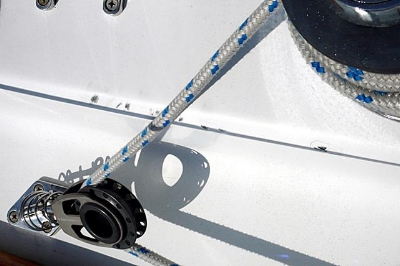Chafe Guards...What's the Rub?
If you’re in the boating world long enough eventually you’ll hear the term ‘chafe guard’ come up. Whether chafe guards are new to you or already part of your day to day, it’s worth spending some time to understand what they are and how they help keep your boat and gear in top notch condition.
What are you protecting?
Before going into the different type of chafe guards, it’s worth asking what are you trying to protect? The term chafe guard means different things to different people depending on their application or more importantly what they are protecting.
In looking at chafe guard products you should consider the end result. What are you trying to protect? Examples of what to consider protecting include:
Vessel top sides (including fiberglass, wood, plastic, or metal surfaces)
Dock, anchor, and mooring lines
Head foils
Running Rigging
Example of running rigging damage on a fiberglass topside.
Depending on what you’re trying to protect you may chose different types of chafe guards.
What type of damage could you see?
In speaking about protecting your vessel and equipment, a natural question is what type of damage can you expect to see? While there isn’t a ‘one sized fits all’ answer, typical damage that can be mitigated from chafe guards include:
Scratches, pitting, and gouges to topside surfaces (including fiberglass and wood). This type of damage creates channels and cuts through the surface itself, which in addition to being unsightly can weaken the surface and make it more susceptible to deeper damage.
Line and sheet damage generally leads to wear and tear at best, and catastrophic damage at its worst. This can start with slight fraying and tears on the outside layers of your lines, but over time this can degrade their ability to perform. When thinking of dock, anchor, and mooring lines, these should be inspected and replaced when signs of wear are present - but note the less protection on those lines the faster deterioration can happen. For those of us who have had to replace lines we all know the expense that can be, not to mention the risk of keeping your vessel in place.
Types of Chafe Guards
Once you have an idea of what you’re looking to protect you should compare that against the types of chafe guard protection that exists in the market. Two main categories of chafe guard protection include:
Static Chafe Guards: These chafe guards are installed in place to provide maximum protection. They do not require any maintenance or updates, and are ‘transparent’ to the user once installed. Static chafe guards excel at protection moving parts such as running rigging where freedom of movement is critical. Examples of static guards include our own No-Wear Guard product line.
Dynamic Chafe Guards: These are chafe guards that can be installed and removed based on need. They are generally applied to lines themselves and provide protection from static scenarios (e.g. dock and anchor lines). These can be removed if desired though do not lend themselves to high movement situations. Examples of these are Chafe-Pro series, Cape Hatteras Wooly, and the Chafe Master line.
Depending on the problem you’re trying to solve there are different solutions to meet your needs. It will also inform you of what you’re trying to protect. Are you most interested in protecting:
Dock lines that can be expensive to replace but easily upgraded?
Fiberglass or wood topside surfaces that may require extensive labor to maintain or repair?
Regardless of the type of chafe guard you install, either one should be with the goal of protecting your boat or gear. Like all parts of your vessel, a little preventative maintenance early on can help save you a lot of time and money downstream. Damage to topsides, lines, and other expensive gear is no exception.
Want to learn more about chafe guards in the market? Stay tuned for future posts on chafe guards and other marine protection products.

